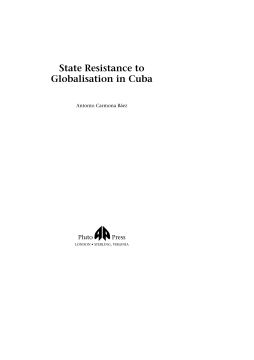
Additional Information
Book Details
Abstract
How has the government and the people of Cuba actively resisted neo-liberal globalisation? How is it that the Cuban Communist Party continues to exist? To what extent is Cuba affected by global trends and pressures?
Antonio Carmona Báez challenges those on the Left who romantically support the Cuban Revolution as well as those who claim that the free market is the ideal economic model for all states. Instead, he presents an intelligent account of the serious and contradictory consequences of Cuba's social, political and economic restructuring.
The author revisits the history of the Cuban Revolution, and the crisis after the fall of Cuba's superpower ally, the Soviet Union, to provide answers to these questions.
Table of Contents
| Section Title | Page | Action | Price |
|---|---|---|---|
| Contents | iii | ||
| 1. Introduction | 1 | ||
| Cuba as an Exception | 2 | ||
| Neo- liberal Globalisation, Socialism and Anti- Imperialist State Resistance | 5 | ||
| Implications for the State | 13 | ||
| Social Consequences of the Global Trends | 14 | ||
| Socialism in a Sea of Capitalism | 16 | ||
| Marxist Socialism | 17 | ||
| State Capitalism | 21 | ||
| Implications for Studying Cuba | 24 | ||
| The Party/ State Apparatus | 34 | ||
| 2. Conceptualising Cuban Socialism: The Pillars of the Revolution | 41 | ||
| The Causes of a Tardy Independence | 42 | ||
| Roots of Nation- state Formation | 43 | ||
| US Intervention and Neo- colonialism | 48 | ||
| The First Labour Movement | 50 | ||
| A Workers' Revolutionary Attempt | 52 | ||
| An Alternative to the Workers' Movement | 60 | ||
| 'Cuba Socialista' | 69 | ||
| Economic Integration into the Soviet Bloc | 79 | ||
| Unity, Continuity, State Supremacy and Popular Participation | 81 | ||
| 3. The Causes and Impact of Cuba's Crisis in the 1990s | 86 | ||
| The Background to the Crisis | 89 | ||
| The Effects of Integration | 90 | ||
| The Campaign to Rectify Errors and Negative Tendencies | 92 | ||
| The Demise of the CMEA | 94 | ||
| Cuba and the Fall of the Soviet Union | 97 | ||
| The US Economic Embargo | 109 | ||
| The State's Response and the Impact upon Cuba's Political System | 117 | ||
| Foreign Direct Investment | 133 | ||
| Signs of Slow Recovery | 139 | ||
| 4. Structural Adjustments and Social Forces in Cuba: How Cuba™s Economic Model was Shaped by Global Trends | 152 | ||
| Demonstrated Economic Growth | 153 | ||
| Causes for Economic Growth | 155 | ||
| Social Growth | 158 | ||
| World Bank Development Reports and Other International Sources | 162 | ||
| Cuba's Most Radical Change - Sistema de Perfeccionamiento Empresarial | 164 | ||
| Cuentapropismo: The New Self- employment in Cuba | 184 | ||
| New Structures | 195 | ||
| New Structures and Social Bloc Formations | 206 | ||
| Structural Changes and the Revolution's Identity | 216 | ||
| 5. Conclusions and Considerations | 223 | ||
| Shaky Pillars? | 226 | ||
| Possible Future Scenarios | 231 | ||
| A Disintegration of the Party/ State Apparatus? | 233 | ||
| Maintaining Cuban Socialism | 235 | ||
| Bibliography | 240 | ||
| Index | 257 |
